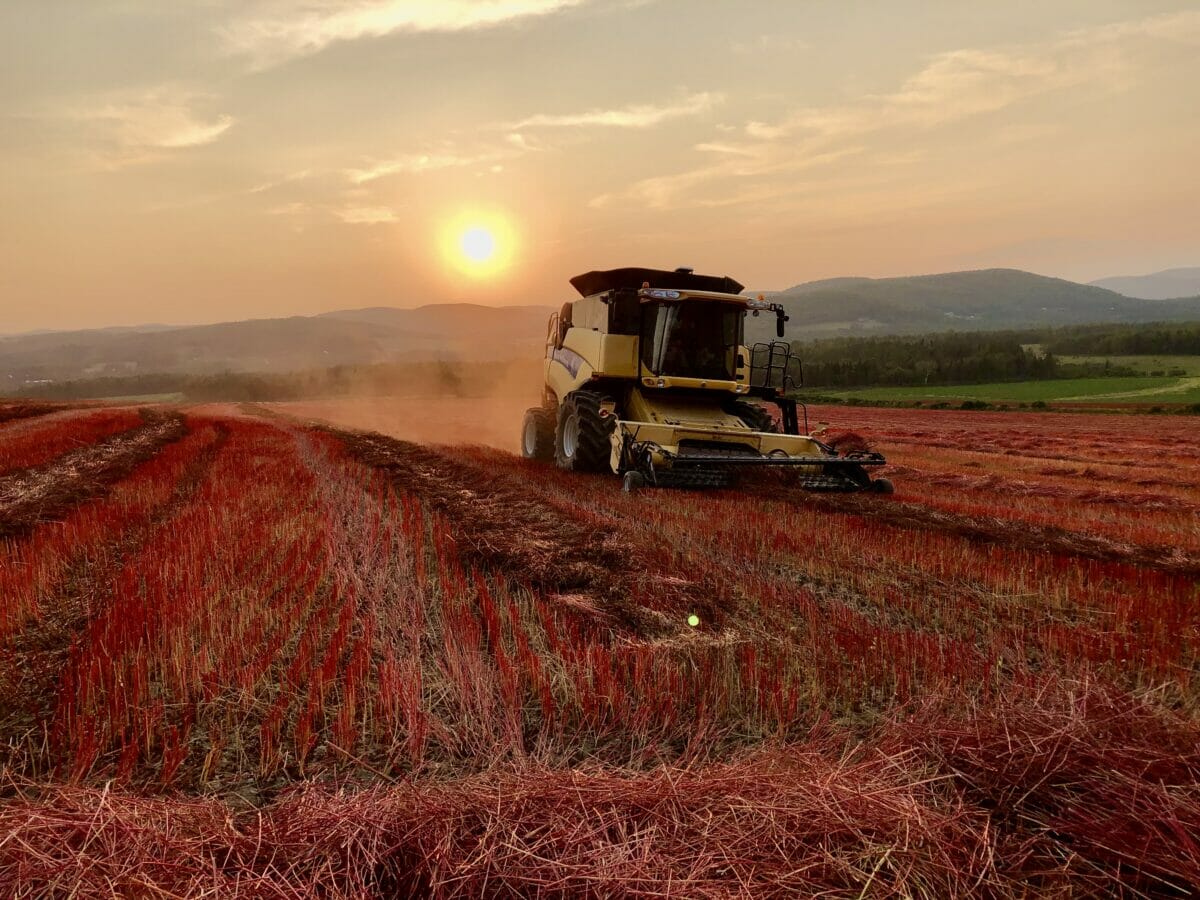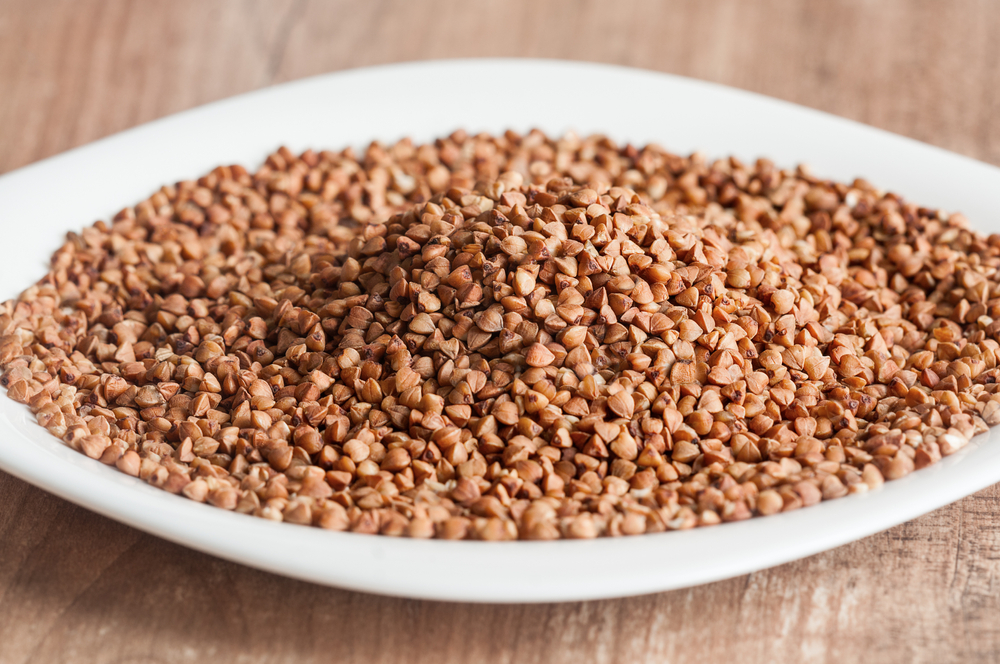Changing Tastes Fuel a Buckwheat Revival
Thanks to the growing demand for gluten-free foods and interest in alternative flours, buckwheat is seeing a resurgence.
Changing Tastes Fuel a Buckwheat Revival
Thanks to the growing demand for gluten-free foods and interest in alternative flours, buckwheat is seeing a resurgence.

Rows planted to buckwheat at Bouchard Family Farms.courtesy of Bouchard Family Farms.
For those in the know, Bouchard Family Farms is the place to go when you need Tartary flour for making French-Canadian pancakes and crepes or Japanese soba noodles. For 30-plus years, the family farm, perched on the tippy top of Maine, has grown Tartary buckwheat and milled it into flour. Over the years, thanks in part to a growing demand for gluten-free foods and interest in alternative flours, it has created a market for buckwheat as both a food and cover crop. Starting to grow it, though, was a risk taken out of necessity.
When Joe Bouchard first planted buckwheat in the 1980s, he did it because he wanted to diversify. For nearly six generations, the farm had grown potatoes and grains such as oats, but as the price of potatoes declined in part due to overseas competition, the farm needed to create new income streams. That’s when it introduced Tartary buckwheat—at the time, a relatively unknown and unused product—to the fields.
“We had to do a lot of food shows to get the word out,” recalls Bouchard. “It was pretty difficult, but then again, everything you do is difficult.”
Despite its name, buckwheat doesn’t contain wheat; it’s not even a grain. Gluten-free, it’s considered a pseudocereal, which are seeds consumed as cereal grains (such as quinoa and amaranth) that don’t grow on grasses. It has a nutty, earthy flavor that, along with its gluten-free trait, makes it popular among bakers.

Buckwheat originated in China and spread worldwide, becoming an essential ingredient for soba noodles, kasha, galettes and more. In the late 1800s, it was incredibly popular both for making flour and animal feed. But as the agricultural system industrialized, the pseudograin fell out of favor—that is, until now.
Today, there are two main types of buckwheat grown: the Tartary buckwheat that Bouchard Family Farms grows and common buckwheat. While both types are similar, Tartary is self-fertile and grows well in cold climates, while common buckwheat requires pollination to reproduce and prefers temperate climates. Tartary buckwheat is also more bitter than common buckwheat, and it is seeing a resurgence of use in crop rotation, which can help build soil health.
“Farmers love it as a short-season, quick-growing cover crop,” says Tom Molloy, an agronomist with the University of Maine Cooperative Extension. “It’s fairly fast growing and it’s competitive with weeds.”
Buckwheat also reportedly takes up phosphorus, a critical nutrient for plant growth, and then releases the nutrients off which later crops thrive. While phosphorus occurs naturally in the soil, farmers add it to the soil to increase soil health and yield, and like many agricultural inputs, it is becoming harder to obtain.
Karen and Steve Getz fell in love with buckwheat in San Jose, California’s Japantown, where soba noodles are made of ancient grain. Karen, who has a background as a baker and cheesemaker, and Steve, who worked for Organic Valley, wanted to create a product using buckwheat. Yet, it wasn’t until they met farmers cultivating Tartary buckwheat in Aroostook County that the pair decided to relocate to Maine to live out their dream of creating Maine Crisps, a line of buckwheat crisps.
“When I was up in Maine’s most Northern Country and I spotted the buckwheat growing, everything came together,” says Karen. “I could combine my love of baking and buckwheat to make something that would be safe for people with celiac disease or a gluten sensitivity to eat while supporting our local farm community.”
Despite its recent resurgence, buckwheat has yet to hit the mainstream. The Getzes get all of their buckwheat from the Bouchard Family Farms, in part because the farm is also able to mill the buckwheat in its certified gluten-free mill, but they believe in the crop’s potential.
“Buckwheat is a great crop because you get two crops out of it really—the buckwheat seed itself but also its flowers and, when it’s in bloom, before those flowers turn into a seed, [it’s where] you get buckwheat honey from,” says Karen.
Throughout Maine, Molloy is seeing steady growth of buckwheat as a cover crop plant, and the Cooperative Extension is encouraging some growers to try it out as a cereal. They’ve seen success with buckwheat cutting back on weeds and diseases when growers of other cereal crops plant it in rotation. The challenge that still exists is helping farmers determine when buckwheat is ready to harvest; unlike other crops that dry out before harvest, buckwheat should still be green when harvested.
“We hope it’s going to increase; we have to continue to market it,” says Bouchard, who, in addition to Maine Crisps, sells his buckwheat to supermarkets and other stores, as well as a good deal of direct-to-consumer shipping.
As the buckwheat resurgence gains momentum in Maine, farmers in other states are taking notice, with farmers in New York working on buckwheat with the Cornell Cooperative Extension and growers from Ohio to Missouri also experimenting with the crop.
Follow us
This work is licensed under a Creative Commons Attribution-NoDerivatives 4.0 International License.
Want to republish a Modern Farmer story?
We are happy for Modern Farmer stories to be shared, and encourage you to republish our articles for your audience. When doing so, we ask that you follow these guidelines:
Please credit us and our writers
For the author byline, please use “Author Name, Modern Farmer.” At the top of our stories, if on the web, please include this text and link: “This story was originally published by Modern Farmer.”
Please make sure to include a link back to either our home page or the article URL.
At the bottom of the story, please include the following text:
“Modern Farmer is a nonprofit initiative dedicated to raising awareness and catalyzing action at the intersection of food, agriculture, and society. Read more at <link>Modern Farmer</link>.”
Use our widget
We’d like to be able to track our stories, so we ask that if you republish our content, you do so using our widget (located on the left hand side of the article). The HTML code has a built-in tracker that tells us the data and domain where the story was published, as well as view counts.
Check the image requirements
It’s your responsibility to confirm you're licensed to republish images in our articles. Some images, such as those from commercial providers, don't allow their images to be republished without permission or payment. Copyright terms are generally listed in the image caption and attribution. You are welcome to omit our images or substitute with your own. Charts and interactive graphics follow the same rules.
Don’t change too much. Or, ask us first.
Articles must be republished in their entirety. It’s okay to change references to time (“today” to “yesterday”) or location (“Iowa City, IA” to “here”). But please keep everything else the same.
If you feel strongly that a more material edit needs to be made, get in touch with us at [email protected]. We’re happy to discuss it with the original author, but we must have prior approval for changes before publication.
Special cases
Extracts. You may run the first few lines or paragraphs of the article and then say: “Read the full article at Modern Farmer” with a link back to the original article.
Quotes. You may quote authors provided you include a link back to the article URL.
Translations. These require writer approval. To inquire about translation of a Modern Farmer article, contact us at [email protected]
Signed consent / copyright release forms. These are not required, provided you are following these guidelines.
Print. Articles can be republished in print under these same rules, with the exception that you do not need to include the links.
Tag us
When sharing the story on social media, please tag us using the following: - Twitter (@ModFarm) - Facebook (@ModernFarmerMedia) - Instagram (@modfarm)
Use our content respectfully
Modern Farmer is a nonprofit and as such we share our content for free and in good faith in order to reach new audiences. Respectfully,
No selling ads against our stories. It’s okay to put our stories on pages with ads.
Don’t republish our material wholesale, or automatically; you need to select stories to be republished individually.
You have no rights to sell, license, syndicate, or otherwise represent yourself as the authorized owner of our material to any third parties. This means that you cannot actively publish or submit our work for syndication to third party platforms or apps like Apple News or Google News. We understand that publishers cannot fully control when certain third parties automatically summarize or crawl content from publishers’ own sites.
Keep in touch
We want to hear from you if you love Modern Farmer content, have a collaboration idea, or anything else to share. As a nonprofit outlet, we work in service of our community and are always open to comments, feedback, and ideas. Contact us at [email protected].by Bridget Shirvell, Modern Farmer
October 21, 2022
Modern Farmer Weekly
Solutions Hub
Innovations, ideas and inspiration. Actionable solutions for a resilient food system.
ExploreExplore other topics
Share With Us
We want to hear from Modern Farmer readers who have thoughtful commentary, actionable solutions, or helpful ideas to share.
SubmitNecessary cookies are absolutely essential for the website to function properly. This category only includes cookies that ensures basic functionalities and security features of the website. These cookies do not store any personal information.
Any cookies that may not be particularly necessary for the website to function and are used specifically to collect user personal data via analytics, ads, other embedded contents are termed as non-necessary cookies.
During the last Cold War the Russian basketball team came to the US to show that in sport we could overcome our political differences. When they discovered there was no buckwheat on the menu they refused to play until some was obtained. The rutin in buckwheat makes a big difference to health and vitality and blood pressure
Very informative article about food and agriculture.